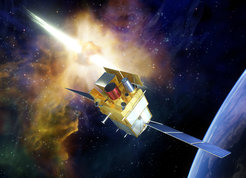CNES and MPE sign agreement for SVOM astronomy mission

SVOM (Space-based multiband astronomical Variable Objects Monitor) is a satellite designed to probe gamma-ray bursts (GRBs), the highest-energy phenomena known in the Universe that are generated from the explosion of massive stars and the merger of compact objects like neutron stars or black holes.
Under the agreement signed by CNES and the China National Space Administration (CNSA) in 2014, CNES is coordinating science and engineering development work for the French contribution to the SVOM mission. In particular, the agency is responsible for the MXT Microchannel X-ray Telescope and the ECLAIRs wide-field X-ray and gamma-ray camera, as well as the associated ground segment.
The Max Planck Institute for Extraterrestrial Physics (MPE), located in Garching, Germany, will provide its scientific know-how and engineering expertise in developing high-energy instruments, and will be using its PANTER test facility to verify instrument performance in the X-ray and gamma-ray domains. It will be involved in developing, testing and operating the focal plane of the MXT instrument and in testing the X-ray spectroscopic imager for ECLAIRs, while also pursuing its science collaboration on the SVOM mission.
After the signature, Jean-Yves Le Gall commented: “CNES is particularly proud to have signed this agreement with the Max Planck Institute. This new partnership shows just how fundamental it is to multiply international cooperation efforts to accomplish large-scale projects like SVOM.”
“We are delighted to be working with our French and Chinese colleagues on this SVOM mission,” says Kirpal Nandra, Director at the Max Planck Institute for Extraterrestrial Physics. “The 2020s will be a particularly exciting time for transient astronomy and we are looking forward to many new discoveries about some of the most energetic phenomena of the universe.”












